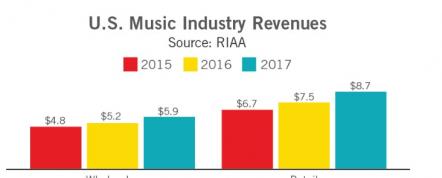New York, NY (Top40 Charts) In 2017 revenues from recorded music in the United States increased 16.5% at estimated retail value to $8.7 billion, continuing the growth from the previous year. At wholesale, revenues grew 12.6% to $5.9 billion.
Similar to 2016, these increases came primarily from growth in paid music subscriptions to services like Spotify, Amazon, Tidal, AppleMusic,
Pandora and others, which grew by more than 50%.
This is the first time since 1999 that U.S. music revenues grew materially for two years in a row. At $8.7 billion, the industry has taken a decade to return to the same overall revenue level as 2008, and is still 40% below peak levels as the growth from streaming has been offset by continued declines in revenues from both physical and digital unit based sales.
STREAMING:
Streaming music platforms accounted for almost 2/3rd of total U.S. music industry revenues in 2017, and contributed nearly all of the growth. The streaming category includes revenues from premium subscription services, streaming radio services including those revenues distributed by SoundExchange (like Pandora, SiriusXM, and other
Internet radio), and ad-supported on-demand streaming services (such as YouTube, Vevo, and ad-supported Spotify).
Paid subscriptions were the biggest growth driver for the music industry in 2017. Year-over-year revenue growth of 63% brought total subscription revenues to more than $4 billion for the first time, making it by far the biggest format of recorded music in the United States, comprising 47% of the total market. Starting in 2016, RIAA began differentiating between full-service paid subscriptions and
some "limited tier" services. This new category includes paid subscriptions for services limited by factors such as mobile access, catalog availability, on-demand limitations, or device restrictions. Services like Amazon Prime,
Pandora Plus, and other subscriptions are included in this category. In 2017, this group represented 14% of the subscription market by value, up from 11% in 2016.
Subscription growth was driven by continued rapid user adoption, as the number of paid subscriptions to full on-demand services grew 56% to average 35.3 million for the year, compared with 22.7 million in 2016. New services like
Pandora Premium, iHeartRadio All Access, and the first full year of Amazon Unlimited added to a growing group of offerings along with established services like Apple Music, Spotify, Tidal, and others. Note the number of subscriptions does not include limited tier services.
Revenues from on-demand streaming services supported by advertising grew 35% to $659 million in 2017. Reports from industry tracking services like the Nielsen Company and Border City Media estimate these services streamed more than 300 billion songs to fans in the United States in 2017, but that figure is understated due to unreported streams on YouTube, the most widely used music service.
Total revenues from digital and customized radio services were $914 million, down 5% versus the prior year. This category includes SoundExchange distributions for revenues from services like SiriusXM and internet radio stations, as well as payments directly paid by services, included in this report as "other ad-supported streaming." These revenues accounted for 29% of the digital and customized radio services category in 2017, up from 8% in 2016.
DIGITAL DOWNLOADS:
Revenues from digital downloads fell 25%, to $1.3 billion in 2017. For the first time since 2011, revenues from physical products exceeded those from digital downloads. Revenues from sales of track downloads were down 25%, and digital album revenue decreased 24% versus 2016.
The total value of digitally distributed formats in 2017 was $7.0 billion, up 22% from the prior year, and contributed 82% of total industry value (note this calculation excludes Synchronization revenues).
PHYSICAL PRODUCTS:
Shipments of physical products decreased just 4% to $1.5 billion in 2017, a lower rate of decline than in recent years. In the first half of the year, the rate of return of physical goods declined, leading to better results. In the second half, those rates returned to more typical levels. Vinyl continues to be a bright spot among physical formats, with revenues up 10% to $395 million. Shipments of CDs continued to decline, falling 6% in 2017 to $1.1 billion. Revenues from shipments of physical products made up 17% of the industry total in 2017.





















